By Jihoon Sung
Despite all the debates and discussions, the pandemic continues to ravage humanity and the fake news phenomenon continues to deceive some people.
On May 3, 2020, the world marked the World Press Freedom Day, paying tribute to journalists of the world who contribute their time and effort to inform the public. The European Union, the United Nation, and the United States put out official statements in celebrating the day, but this particular year, these statements had a unique common theme: accuracy in the time of coronavirus pandemic. This article will explore the climate of freedom of speech in the midst of a deadly pandemic, alongside the ‘fake news’ phenomenon that is known to promote misinformation into people’s media diets. It will discuss the nature of fake news, sustaining freedom of speech that coexists with fake news, and potential misinformation management proposed by scholars.
The ‘fake news’ phenomenon had been ongoing even before Trump popularised the term during the 2016 United States Presidential Election whenever he was faced with unfavourable media coverage. According to Alcock, the current fake news phenomenon resembles early forms of propaganda, perhaps in one way, similar to tactics used by the Nazi regime during the Second World War, which involved “making false news seem genuine and making genuine news seem false”.[1] With the coronavirus pandemic on-going, fake news became more vibrant and social media companies have come under pressure to restrict such information from their platforms.
There is a division between scholars on how false information ended up on people’s media diet. Zaller argued that freedom of speech involves creating a climate where people do not fear speaking. But certain figures abuse this climate to gain fame and profit by spreading false information.[2] Borchers claims that false news emerges with a lack of news literacy education, where it keeps people, and Trump, in their information bubble, which often has false information floating around.[3] Both claims have plausibility and flaws, and highlight how vulnerable people currently are to fake news.
During a pandemic, misinformation and fake news can be a matter of life and death for some people. With news such as coronavirus was caused by the 5G network, taking hydroxychloroquine as a miracle cure, or believing coronavirus is a political hoax that will magically go away by the end of the year, questions arise around the amount of liberty that one should have in speech that has a potentially negative effect on vulnerable people. Mudde sees a dilemma of managing freedom of speech in a pandemic. He explains the urgent need for restricting false information in media to protect frontline workers from becoming silenced, while preventing a fall into the trap of giving political leaders “dictatorial powers” of taking away too much freedom of speech, such as in Hungary for example.[4] Mudde did not explain how to achieve such balance, but he emphasised that it is crucial that people fight against leaders using authoritarian measures in response to the pandemic.
The current state of the fake news phenomenon highlights the ongoing debate of how to balance freedom of speech and censorship more than before. Governments and media outlets are experimenting with how to responsibly minimise the dire influence that false information can have. Alcock proposes tackling fake news similarly to the way allies tackled Nazi propaganda during the Second World War: forewarning, counterpropaganda, ‘focus on truth’, and critical thinking. Forewarning is about detecting the misinformation before it spreads; counterpropaganda is about attacking false claims directly; ‘focus on truth’ is consistently providing accurate information to gain trust amongst the population, and critical thinking is “encouraging the critical analysis of information”.[5] Borchers proposes more news literacy in the education system, following the PEN America’s recommendation, with a competent warning system that would prevent fraudulent news purveyors from profiting.[6]
Despite all the debates and discussions, the pandemic continues to ravage humanity and the fake news phenomenon continues to deceive some people. The challenge of both sustaining freedom of speech and containing fake news continues, and time will tell whether we have succeeded in finding this balance. Scholars have shown different approaches to tackling the fake news phenomenon, and now, in the midst of a pandemic where people’s lives are at stake, the solution for this freedom of speech and fake news containment dilemma has become more urgent.
References:
[1] Alcock, James, “Free Speech and Propaganda”, Humanist Perspectives, Issue 207 Winter 2018-19 p.35
[2] Zaller, Robert, “Free speech propaganda and the right to be heard”, University Wire, pp.2-3
[3] Borchers, Callum, “How to squash fake news without trampling free speech”, Washington Post, 12th October 2017
[4] Mudde, Cas, “Don’t let free speech be a casualty of coronavirus. We need it more than ever.”, The Guardian, Published 6th April 2020, Retrieved on 21st May 2020, from https://www.theguardian.com/commentisfree/2020/apr/06/coronavirus-free-speech-hungary-fake-news
[5] Alcock, p.36-7
[6] Borchers.
Jihoon Sung is a Master of Arts student at the University of Auckland, studying Politics and International Relations.
Disclaimer: The ideas expressed in this article reflect the author’s views and not necessarily the views of The Big Q.
You might also like:
Q+A: How do we solve incivility in society?

